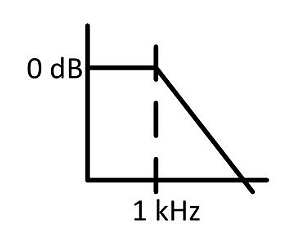Question:
In a bode magnitude plot, which one of the following slopes would be exhibited at high frequencies by a 4th order all-pole system?
In a bode magnitude plot, which one of the following slopes would be exhibited at high frequencies by a 4th order all-pole system?
Show Hint
Bode Plot Slopes. Each pole contributes -20 dB/decade (-6 dB/octave) to the magnitude slope at high frequencies. Each zero contributes +20 dB/decade (+6 dB/octave). The net high-frequency slope depends on the difference between the number of poles and finite zeros (relative degree). For an n-th order all-pole system, the high-frequency slope is -20n dB/decade.
Updated On: May 7, 2025
- -80 dB/decade
- -40 dB/decade
- 40 dB/decade
- 80 dB/decade
Hide Solution
Verified By Collegedunia
The Correct Option is A
Solution and Explanation
A Bode magnitude plot shows the logarithm of the magnitude of a system's frequency response (\(|H(j\omega)|\)) versus the logarithm of frequency (\(\omega\))
The slope of the plot indicates how the magnitude changes with frequency
An all-pole system has a transfer function with poles but no finite zeros
The high-frequency behavior is dominated by the poles
Each pole contributes a slope of -20 dB/decade to the magnitude plot beyond its corner frequency
A 4th order all-pole system has 4 poles
At high frequencies (well beyond all pole corner frequencies), the contributions from all 4 poles add up
Total high-frequency slope = (Number of poles) \(\times\) (-20 dB/decade/pole) Total slope = 4 \(\times\) (-20 dB/decade) = -80 dB/decade
The slope of the plot indicates how the magnitude changes with frequency
An all-pole system has a transfer function with poles but no finite zeros
The high-frequency behavior is dominated by the poles
Each pole contributes a slope of -20 dB/decade to the magnitude plot beyond its corner frequency
A 4th order all-pole system has 4 poles
At high frequencies (well beyond all pole corner frequencies), the contributions from all 4 poles add up
Total high-frequency slope = (Number of poles) \(\times\) (-20 dB/decade/pole) Total slope = 4 \(\times\) (-20 dB/decade) = -80 dB/decade
Was this answer helpful?
0
0
Top Questions on Bode Plot
- In a bode magnitude plot, which one of the following slopes would be exhibited at high frequencies by a 4th order all-pole system?
- The Bode plot of a 2nd order low pass filter is shown in the figure below. What is the frequency at which the attenuation is 80 dB ?

- The magnitude and phase plots of an LTI system are shown in the figure. The transfer function of the system is: \begin{center} \includegraphics[width=0.45\textwidth]{15.jpeg} \end{center}
- The Bode magnitude plot of a first order stable system is constant with frequency. The asymptotic value of the high frequency phase, for the system, is -180°. This system has

- In a unity-gain feedback control system, the plant \[ P(s) = \frac{0.001}{s(2s + 1)(0.01s + 1)} \] is controlled by a lag compensator \[ C(s) = \frac{s + 10}{s + 0.1} \] The slope (in dB/decade) of the asymptotic Bode magnitude plot of the loop gain at \( \omega = 3 \, \text{rad/s} \) is _________ (in integer).
Questions Asked in AP PGECET exam
Digital signatures provide ________.
- AP PGECET - 2025
- Computer Networks
- A number is selected randomly from each of the following two sets:
{1, 2, 3, 4, 5, 6, 7, 8}, {2, 3, 4, 5, 6, 7, 8, 9}
What is the probability that the sum of the numbers is 9?- AP PGECET - 2025
- Probability and Statistics
- The ratio of the ages of A and B is 5:3. After 6 years, their ages will be in the ratio 6:4. What is the current age of A?
- AP PGECET - 2025
- Ratio and Proportion
- ________ function is performed by data input/capture subsystem of GIS.
- AP PGECET - 2025
- Geographic Information System - GIS
- Consider the system of equations:
\[ x + 2y - z = 3 \\ 2x + 4y - 2z = 7 \\ 3x + 6y - 3z = 9 \]
Which of the following statements is true about the system?
- AP PGECET - 2025
- Linear Algebra
View More Questions